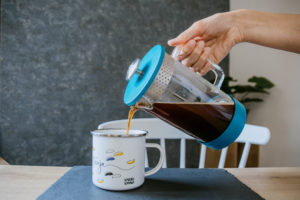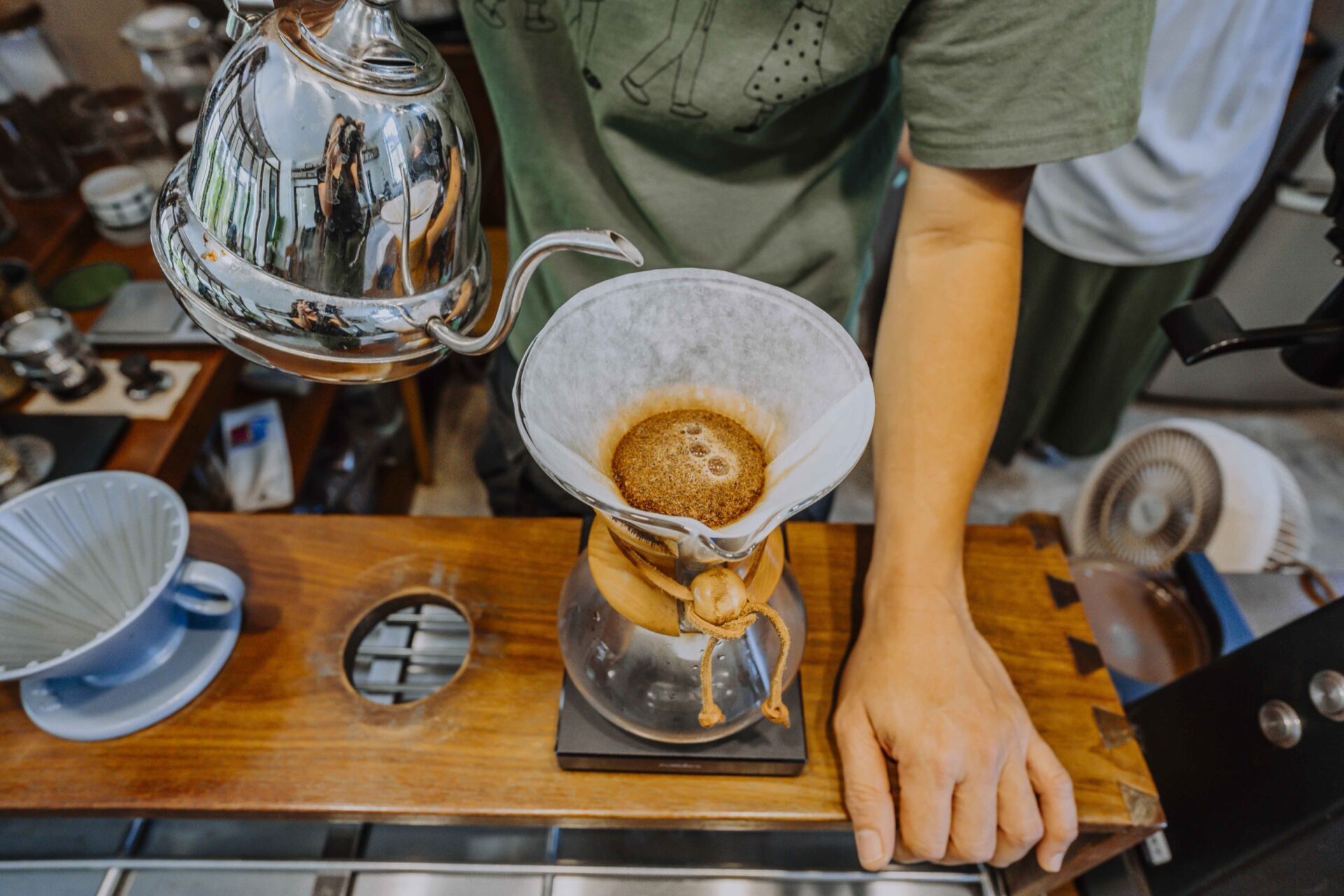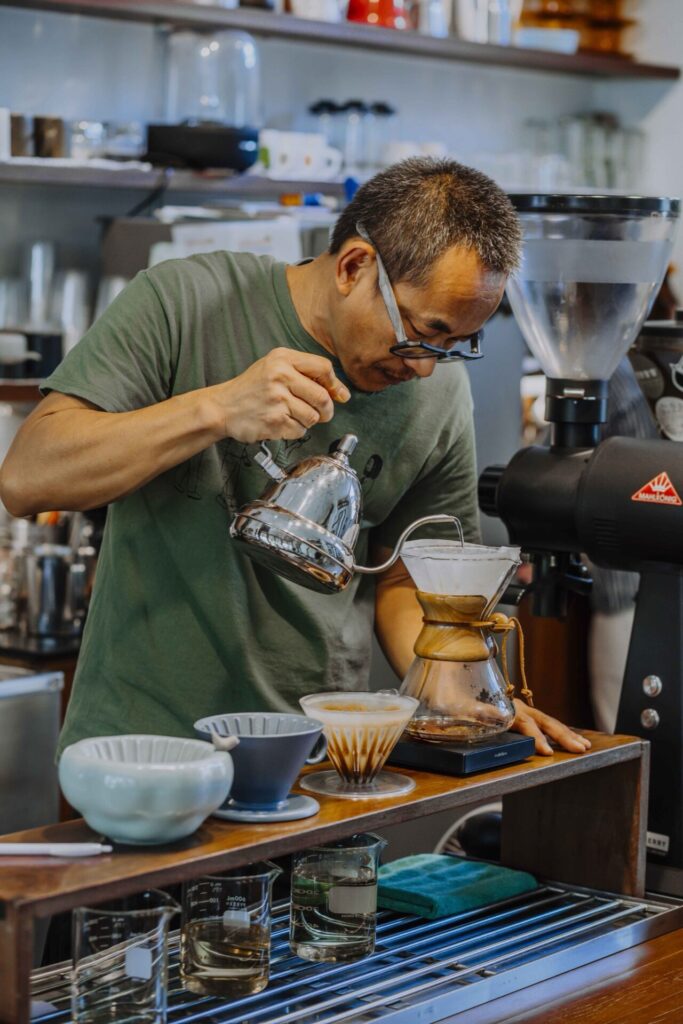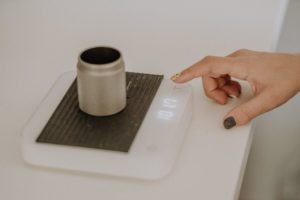
What is the Ideal Chemex Coffee Ratio?

After extensive testing with different coffee to water ratios together with the coffee expert Piyachat Trithaworn, who is also known as the king of drip by industry folks, and analyzing the science behind extraction, this guide breaks down everything you need to know about dialing in your Chemex brew ratio. A brew ratio is simply the amount of coffee to water you use when making your coffee. It’s usually written as something like 1:15, which means for every 1 gram of coffee, you’d use 15 grams of water. Check out my Chemex Ratio Calculator below for getting a quick recipe adapted to the size of your Chemex.
Calculate Your Ideal Coffee to Water Ratio for Chemex
Chemex Ratio Calculator
Testing Three Coffee Ratios for Chemex
Piyachat and I tested three coffee ratios for Chemex with a naturally processed, light roast coffee from Thailand (Wiang Pa Pao, Chiang Rai) to find out which ratio would work best. I summarized the results of our experiment in a table for your to get a quick overview of the brew ratios we tested and what the coffee tasted like as a result.
| Brew Ratio | Coffee | Water | Tasting Notes |
|---|---|---|---|
| 1:12 | 20 g 0.71 oz | 240 g 8.12 fl oz | More body and acidity, less sweetness; stone fruit notes (yellow plum). Strong, heavy cup — best for iced or dessert coffee. |
| 1:14 | 20 g 0.71 oz | 280 g 9.47 fl oz | Sweet, sugarcane-like notes; light acidity, medium-light body; honey and plum emerge on cooling. Very good balance. |
| 1:17 | 20 g 0.71 oz | 340 g 10.5 fl oz | Floral hints (orange blossom, white tea), but muted by slight bitterness. |
In our controlled experiment with light-roasted Thai beans, the three distinct coffee ratios revealed very different flavor profiles:
1:12 Ratio: Using 20g coffee to 240g water, this ratio delivered intense body and pronounced acidity. Stone fruit notes dominated, particularly yellow plum. This concentrated brew works brilliantly over ice or as an after-dinner coffee, though daily drinkers might find it heavy.
1:14 Ratio: The sweet spot for most palates. With 20g coffee to 280g water, this ratio extracted clean sweetness reminiscent of sugarcane, with honey and plum notes emerging as the coffee cooled. Medium-light body with gentle acidity made this supremely drinkable.
1:17 Ratio: At 20g coffee to 340g water, delicate white tea and orange blossom notes appeared, but bitterness crept in. The coffee lacked the depth of tighter ratios.
This range of results highlights why getting the ratio right is so important. Every coffee brews differently. So with each new coffee, you need to start from scratch and find the coffee ratio that brings out the flavors best.
Chemex Brew Guide (1:14 Ratio, 6-Cup) – Step by Step
Here is the winning recipe from our experiment. It works best with light roast coffees to highlight sweetness. This recipe is input-based (the amount of water you add). Expect 40 g retained in the filter with a 20 g dose.
Target ratio: 1:14
Recipe: 20 g coffee with 280 g water at ~92 °C / 198 °F.
Pour plan: 40 g → 40 g → 80 g → 80 g → 40 g (five pours total)
What you need
- 6-cup Chemex with filter
- 20 g freshly ground coffee (medium grind)
- 280 g hot water at ~92 °C (198 °F)
- Kettle (gooseneck helps), scale, and timer

- Prep your Chemex. Place the filter in the Chemex. Set it on a scale and tare to zero.
- Rinse the filter. Pour hot water through the filter to remove paper taste and preheat the vessel. Discard the rinse water.
- Add coffee. Put 20 g coffee in the filter. Shake gently to level the bed.
- Bloom — First pour
Start by pouring 40 g of water in gentle circles, beginning near the filter wall and spiraling toward the center. Let it sit for 30 seconds to release gases. - Second pour
Add another 40 g of water in the same circular motion, bringing you to 80 g total. - Third pour
Slowly add 80 g of water to reach 160 g total. Keep the pour steady. - Fourth pour
Add another 80 g of water, to 240 g total. - Fifth and final pour
Adding 40 g of water to reach 280 g total. Let the water draw down completely.
Check out my Chemex Brew Guide with a Barista Champion for more detailed Chemex brew instructions.
Chemex-Specific Variables for Choosing the Right Coffee Ratio
Two things make the Chemex behave differently from most drippers and directly affect the ratio you should choose and how you dial in:
The filter — Chemex filters are 20–30% thicker than many competitors. That extra density leads to exceptional clarity but also slower drawdown, requiring specific adjustments.
The geometry — A wide cone and large filter area spreads the coffee bed out. That makes flow want to go faster, while the thick paper makes it want to go slower. Your grind, agitation, and ratio are how you balance those two forces.
1. Start With the Ratio
1:12 (stronger cup): coarsen grind slightly vs V60; gentle pours.
1:14–1:18 (lighter cup): grind slightly finer; Chemex clarity helps sweetness.
Rule of thumb: Adjust grind first, then tweak ratio for body/clarity.
2. Agitation & Pour Style
Bloom briefly.
Use small circular pours from wall to center.
Gentle pencil-thin stream, avoid heavy stirring.
Light swirl is enough; only stir if channels appear.
Troubleshooting Your Brew
Start somewhere between 1:14 and 1:18 coffee:water, 195–205°F (90–96°C) water temperature, a medium-coarse grind, total brew time 4–5 minutes, and make sure the three-ply side of the Chemex filter faces the spout to vent air.
What you can do when your Chemex coffee tastes sour or thin (typically under-extracted)
✔ Grind finer
✔ Raise water temp toward the upper end of the 195–205°F range (a couple °F hotter).
✔ Bloom 45 seconds to wet and degas thoroughly.
✔ Ratio tweak: Nudge stronger to 1:15 (even 1:14 with some darker roasts). Note this affects strength more than extraction—fix grind/temperature first.
What you can do when your Chemex coffee tastes bitter or astringent (typically over-extracted)
✔ Grind coarser
✔ Lower water temp a few °F (but stay within 195–205°F).
✔ Open the ratio to 1:16 or 1:17 for a lighter, cleaner cup.
✔ Pour more gently / lower height to reduce agitation; excessive agitation can increase extraction and prolong drawdown.
How to fix slow drawdown (> ~6:00)
✔ Grind coarser (Chemex filters are thick; too fine clogs easily).
✔ Minimize fines migration: keep pours controlled; avoid aggressive, high-height streams that shake the bed and move fines to the filter.
✔ Pre-rinse the filter thoroughly and keep the spout vent open (three-ply side at the spout) so air can escape.
✔ Water quality: minerals affect flavor and extraction more than flow, but using properly balanced water improves consistency.
How to fix fast drawdown (< ~4:00)
✔ Grind finer to add resistance and increase extraction.
✔ Pour lower and/or use pulse pours to avoid lifting the bed.
✔ Break up clumps at bloom (stir or gentle swirl) to curb channeling.
✔ If issues persist: check burr condition/alignment. Poor uniformity creates outsized boulders (fast flow) and extra fines (uneven extraction).
The Science Behind Coffee Ratios
When people talk about “brew ratio,” they’re really talking about the relationship between the amount of ground coffee and the amount of water you use. It’s one of the biggest lever you have for changing flavor in your cup.
The Specialty Coffee Association (SCA) sets the classic target at about 55 grams of coffee per liter of water (±10%). In everyday language, that works out to somewhere around 1:15 to 1:18 coffee-to-water. Brew within that window and you’re more likely to land in the “Gold Cup” zone:
Strength (TDS): about 1.15–1.35% dissolved coffee solids in the cup.
Extraction yield: about 18–22% of the coffee grounds’ mass actually dissolves into the water.
That’s the sweet spot where most coffees taste balanced — bright but not sour, sweet, and complex without being harsh.
Why temperature matters
Water temperature isn’t just about “hot enough to brew.” Different compounds in coffee dissolve at different temperatures. 195–205°F (90–96°C) is the safe range:
Go hotter, and you’ll pull out more bitter polyphenols and harsher woody notes.
Go cooler, and you risk under-extracting — leaving behind the sugars and aromatics that make coffee sweet and layered.
Temperature and ratio work hand-in-hand. A finer grind or lower ratio may need water closer to 195°F to avoid over-extraction, while a coarser grind or higher ratio might do better with water closer to 205°F.
Ratios and extraction aren’t linear
Here’s the subtle bit: moving from 1:15 to 1:18 doesn’t just make coffee taste weaker or stronger. It changes what actually ends up in your cup.
Early in extraction, water dissolves the bright acids and sweet simple sugars.
Middle stages bring out deeper caramelized sugars and fruit complexity.
Late extraction pulls more bitter tannins, caffeine, and woody compounds.
A stronger ratio (like 1:15) increases the concentration gradient between grounds and water. That means water can grab soluble material faster, and it spends a bit more time in contact with the bed of coffee. You get more body, more intensity, but also run closer to the edge of over-extraction if you push too far.
A lighter ratio (like 1:17 or 1:18) dilutes the coffee more and makes it easier to keep extraction in balance. You’ll often get a cleaner, tea-like profile – but if grind or time aren’t adjusted, you might lose sweetness and end up with something a little flat.
Final Thoughts on the Ideal Chemex Coffee Ratio
Your perfect Chemex ratio depends on beans, water, grinder, and personal preference. Start with 1:15 as your baseline, then adjust based on taste. Keep detailed notes – coffee variety, roast date, grind setting, water temperature, ratio, and tasting notes. Patterns emerge quickly.
Remember that each coffee demands its own recipe. A washed Ethiopian might excel at 1:17, while a natural Brazilian shines at 1:14. The ratios here provide starting points for your own exploration.
Consistency matters more than perfection. Once you find your ratio, stick with it for a while before adjusting. Small changes – one grind click, 5g water, 2°F temperature – reveal their impact better than dramatic shifts.
The Chemex rewards patience and precision. Master coffee ratios, and you’ll extract every ounce of potential from your beans. Enjoy!

